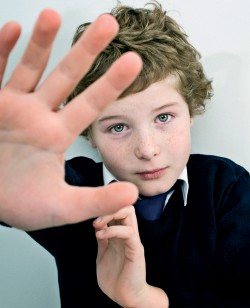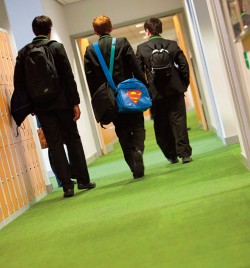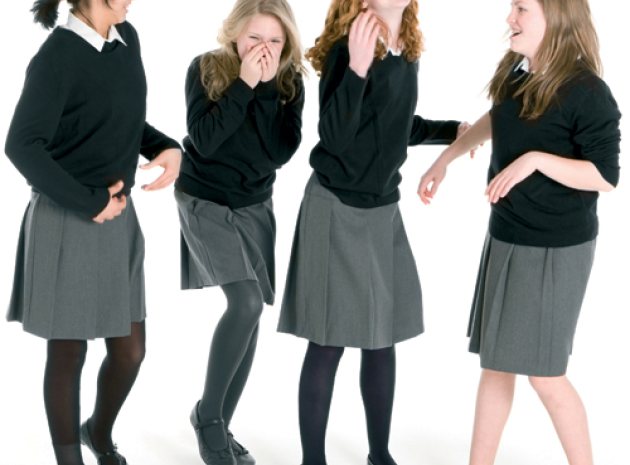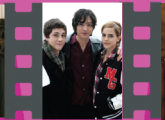Today you will…
Identify the places where bullying can happen thoughtlessly begin to explore how by turning a blind eye to bullying, you become complicit in it discuss the ways in which we can stop bullying and create an anti-bullying culture.
Bullying. Everyone knows it’s wrong. Everyone knows that bullies are bad, or sad, and that they need to be stopped. Everyone knows how a victim feels, and the kinds of words and actions that have impacted on them. By the time they reach KS4, pupils will have revisited this many times over their school career. It can be hard to make it feel relevant. They’ve maybe found it useful to help them tell someone trusted when they’ve been hurt themselves, but, after all, none of them are bullies. Are they?
This lesson seeks to challenge students. To push them to realise that bullying can sometimes happen thoughtlessly. That standing by, and turning a blind eye, allows a culture where bullying is covertly accepted to thrive. That the bully in the room could easily be them. They will discover the places where bullying can insidiously slip into their life, and identify ways to make a difference and turn their culture around to one where bullying is no longer supported.
Starter activity
‘You can’t take it back’
Each group is given a tube of toothpaste and a strip of masking tape. Little by little, they are to squeeze the paste out along the masking tape, stuck to their table. Once they’ve made a line right along the tape, they’re asked to put the toothpaste back in the tube. Give them a minute or so to discover that this is impossible. Ask them how they think this fits in with bullying. Draw out the fact that it can be very easy for hurtful words or actions to just ‘slip out’, much like the toothpaste in the tube. Discuss how this might happen – for example, it is very easy to type something online and press enter or send before you’ve really thought through how it will affect the person at the other end. Once you’ve let the words loose, so to speak, you can’t clutch them back.
‘Words stick’
Each group is given a mirror and some dry wipe pens. Explain that as this is a lesson about bullying, you’d like them to write on the surface of the mirror some of the negative words they might hear a bully use. Once they have run out of ideas, ask them to use the mirror to look at their reflection. Can they see themselves clearly? This is how bullying can affect someone’s self image. He/she begins to see him/herself through the insults of the bully, and can no longer see him/herself clearly in a positive way. Words, whether spoken or written, don’t just stay in the air or on the screen, but work themselves into the person’s mind and stick there, distorting his or her vision.
Main activities

1. ‘Cyber target’
Tell the class about Daniel, who produced an unkind video making fun of Harry, and uploaded it online. He posted links on his social networking pages, and the video got an increasing stream of visitors, who watched it and then also left derogatory comments about Harry. Some people watched it, but didn’t comment, as they felt it was unkind.
Give each group a sheet with four concentric circles, set out like a target. They write ‘Harry’ in the middle circle, ‘Daniel’ on the next circle out, ‘people who left a comment’ on the circle after that, and ‘people who didn’t comment’ on the outside circle.
In one colour pen, they write on how Harry is feeling in the centre circle. They use the same pen to write some reasons for Daniel’s actions in his circle. Ensure that they understand that whatever Daniel’s reasons for creating the video, they are not ‘good enough’ to excuse his bullying behaviour. Use the pen to describe some reasons why people left derogatory comments. Do the students think that everyone who wrote something unkind really meant it? Why might people have written things they didn’t really mean? Draw out the fact that sometimes people go along with bullies and bullying behaviour so that they feel accepted themselves, or because they’re afraid of being the next target. In the final circle, write on how the people who watched and didn’t comment might be feeling. It can be very worrying and confusing to be a bystander of bullying, and it’s also the most common role in the whole scenario, so it’s worth unpacking a little. Briefly feed back on students’ comments with the whole class, to ensure that everyone has understood the ideas.
Now, in a different coloured pen, students should write on the ‘target’ something they would like to say or suggest to each of the people involved. They may well come up with some creative ideas to support Harry as he deals with the effects of the video, to encourage Daniel to use his skills in positive ways, to help the commenters understand the part they’ve played, and to show the bystanders how they can make a difference, rather than just watch.

2. ‘Turning things around’
Spend a short time discussing how it is students’ actions and words that make their school what it is. Not just whether they use actions and words to hurt others, or make peope feel small, but whether they use actions and words to show that such behaviour is not acceptable. They can give some examples of ways to show that bullying is not tolerated in their school, although check these for sense and safety!
Give each group two pieces of paper, some pens, glue and a pair of scissors. Get them to cut one of the sheets of paper in half down the middle, to make two equally sized pieces. On one of these, they use dark depressing colours to show with words or pictorially how their school would be with a culture of bullying being left unchallenged, and so almost acceptable. On the other, they use bright cheerful shades to show their school with a strong anti-bullying culture, including specifics for how this is happening. Students fold the uncut piece of paper into eight zig-zags (concertina-style), and cut each of the coloured pieces into four, vertical strips. Bear with me – this will all make sense in a minute! They glue the coloured strips alternately onto the folded sheet (dark, light, dark, light etc.) until they’re all stuck on. If they look at the 3-D, zig-zag picture from one direction, they can only see the depressing picture of unchecked bullying and the misery it causes. However, if they turn the page around slightly, this will vanish, and they’ll see their school as a bright and hopeful place. Challenge them to make that vision a reality.
Home learning
Challenge your class not just to have taken part in a lesson today, but to take something real away from it, which they can use to make their school, and the wider world around it, a better place. Give out wallet-sized cards with ‘Be the change you want to see’, ‘If not you, then who? If not now, then when?’ and any other similar ‘taking responsibility’ type sayings you can think of!
Summary
Share the work they’ve done. Remind students that bullying is not something we teach them about just because it takes place at school – it can happen anywhere, to anyone, however old they are. It’s not something that stops at statutory school leaving age. It’s useful to have spent time thinking about how easily it can happen, and how important our reaction to it is, even if we’re only watching it occur, as it’s something that we’ll no doubt see on occasions throughout our life. Our response to it can change the culture around us for the better.
Info bar
Additional resources
About the expert
Rachel Summers believes there’s nothing more fun in teaching than creating opportunities for pupils to discover new knowledge for themselves. She enjoys playing around different ideas with pupils of all ages, and is especially happy when the results surprise them both.










